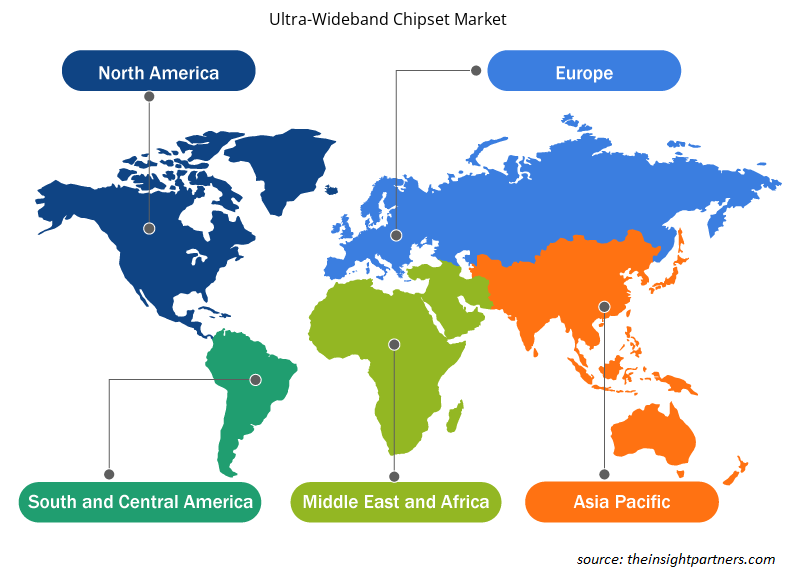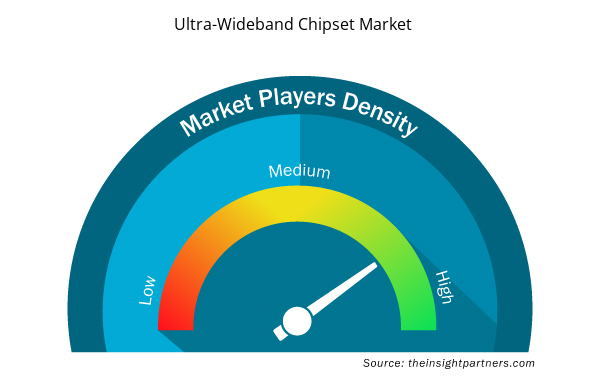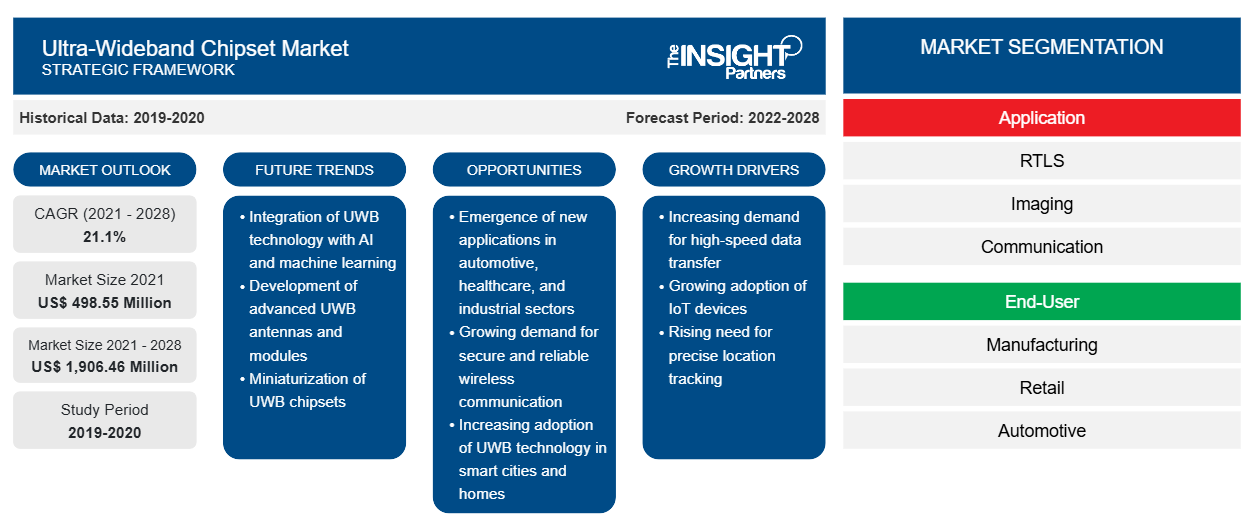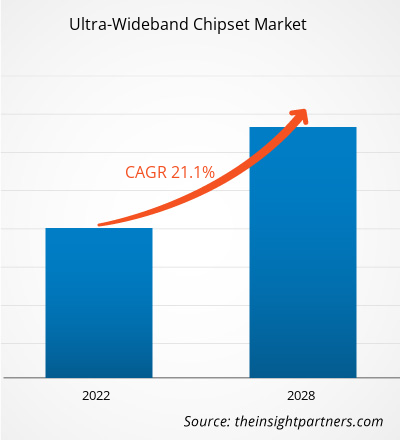Il mercato dei chipset a banda ultralarga è stato valutato 498,55 milioni di dollari nel 2021 e si prevede che raggiungerà 1.906,46 milioni di dollari entro il 2028; si stima che crescerà a un CAGR del 21,1% dal 2021 al 2028.
L'ultra-wideband è una delle tecnologie in crescita adottate nei sistemi di localizzazione in tempo reale (RTLS) con un potenziale di crescita considerevole dovuto alla sua maggiore accuratezza nel tracciamento degli oggetti. La tecnologia UWB offre elevata accuratezza e ampia portata e un consumo energetico inferiore rispetto ad altre tecnologie RTLS come RFID; ciò ha portato a una maggiore penetrazione della tecnologia UWB in applicazioni che richiedono elevata accuratezza. Grazie a questa maggiore accuratezza della tecnologia UWB, diversi utenti finali di RTLS sono passati da RFID e Wi-Fi alla tecnologia UWB per migliorare l'efficienza del prodotto. Inoltre, le soluzioni RTLS integrate in UWB offrono vari vantaggi alle applicazioni RTLS, guidando così il mercato dei chipset a banda ultra-larga
Personalizza questo report in base alle tue esigenze
Riceverai la personalizzazione gratuita di qualsiasi report, comprese parti di questo report, o analisi a livello nazionale, pacchetto dati Excel, oltre a usufruire di grandi offerte e sconti per start-up e università
- Scopri le principali tendenze di mercato in questo rapporto.Questo campione GRATUITO includerà analisi di dati che spaziano dalle tendenze di mercato alle stime e alle previsioni.
Impatto della pandemia di COVID-19 sulle dimensioni del mercato dei chipset a banda ultralarga dell'Asia-Pacifico
A causa della pandemia di COVID-19, diverse regioni hanno sofferto molto, in particolare la regione Asia-Pacifico. I settori manifatturieri in tutto il mondo hanno sperimentato una bassa produzione e una catena di fornitura più debole. Inoltre, la carenza di manodopera ha colpito anche l'industria manifatturiera. Anche gli impianti di produzione di sistemi basati su UWB sono stati chiusi o non sono stati in grado di produrre una capacità totale, il che ha influenzato negativamente i ricavi delle aziende dal 2020 a metà del 2021 e ha comportato una crescita più lenta nel breve termine. Tuttavia, con il crescente utilizzo della tecnologia di monitoraggio remoto, gli strumenti di gestione software potrebbero portare a una maggiore adozione durante il periodo post-COVID. Quindi, l'impatto complessivo di COVID-19 sul mercato dei chipset a banda ultra larga in tutto il mondo è basso o moderato.
Approfondimenti di mercato – Mercato dei chipset a banda ultralarga
La crescente adozione della tecnologia UWB nel monitoraggio dei dispositivi personali e di consumo stimola la crescita del mercato dei chipset a banda ultra larga
UWB migliora significativamente l'esperienza del consumatore di prodotti di intrattenimento domestico come laptop, TV e audio. Ciò ha portato a una maggiore adozione della tecnologia UWB e alla fine aumenta la crescita del mercato dei chipset a banda ultra larga. Viene anche utilizzato per tracciare gli oggetti personali. Ad esempio, il chip Apple U1 per la consapevolezza spaziale è integrato negli iPhone 11, 12 e 13. Inoltre, dopo Apple, vari produttori di smartphone hanno integrato la tecnologia UWB nei loro prodotti, contribuendo alla crescita del mercato dei chipset a banda ultra larga. Inoltre, nell'aprile 2021, Apple ha rilasciato AirTag con tecnologia UWB, dopodiché Samsung ha lanciato ufficialmente il suo tracker Galaxy SmartTag+ comprendente UWB. Pertanto, l'aumento del tasso di adozione contribuisce alla crescita del mercato dei chipset a banda ultra larga. significantly enhances the consumer experience of home entertainment products such as laptops, TV, and audio. This has led to increasing UWB technology adoption and eventually boosts the ultra-wideband chipset market growth. It is also being used to track the personal item. For example, the Apple U1 chip for spatial awareness is integrated into iPhones 11, 12, and 13. In addition, after Apple, various smartphone manufacturers have integrated UWB technology in their products, contributing to the growth of the ultra-wideband chipset market. Moreover, in April 2021, Apple released AirTag with UWB technology, post which Samsung officially launched its Galaxy SmartTag+ tracker comprising UWB. Thus, the surge in adoption rate contributes to the growth of the ultra-wideband chipset market.
Approfondimenti basati sulle applicazioni
In base all'offerta, il mercato dei chipset a banda ultra larga è segmentato in RTLS, imaging e comunicazione. Il segmento della comunicazione ha guidato il mercato nel 2021. La comunicazione wireless UWB trasmette dati considerevoli su un ampio spettro di frequenze che va da 3,1 a 10,6 GHz. Include applicazioni di misurazione della distanza, autenticazione, USB wireless e trasferimento dati. Inoltre, la domanda di sistemi di comunicazione wireless a banda larga è aumentata in modo significativo, a causa di applicazioni emergenti come la rete mobile ad hoc e la raccolta dati tramite una rete di sensori wireless , guidando la domanda di dimensioni del mercato dei chipset a banda ultra larga.ultra-wideband chipset market is segmented into RTLS, imaging, and communication. The communication segment led the market in 2021. UWB wireless communication transmits considerable data over a broad frequency spectrum ranging from 3.1 to 10.6 GHz. It includes ranging, authentication, wireless USB, and data transfer applications. Furthermore, the demand for wireless wideband communications systems has increased significantly, owing to emerging applications such as mobile ad-hoc networking and data collection through a ultra-wideband chipset market size.
Il mercato dei chipset a banda ultra larga è segmentato in base all'applicazione, all'utente finale e alla geografia. In base al tipo, il mercato dei chipset a banda ultra larga è categorizzato in sistemi di misurazione delle immagini e sistemi di misurazione non di immagini. In base all'utente finale, il mercato dei chipset a banda ultra larga è segmentato in produzione, vendita al dettaglio, automotive, assistenza sanitaria ed elettronica di consumo. Geograficamente, il mercato dei chipset a banda ultra larga è segmentato in Nord America, Europa, Asia Pacifico (APAC) e resto del mondo. ALEREON, INC.; Apple Inc.; Bespoon SAS; Decawave Limited; TAIYO YUDEN CO., LTD.; Taoglas; Johanson Technology, Inc.; NOVELDA; NXP Semiconductors NV; e Pulse-Link, inc. sono tra i principali attori profilati durante lo studio del mercato dei chipset a banda ultra larga.ultra-wideband chipset market is segmented based on application, end user, and geography. Based on type, the ultra-wideband chipset market is categorized into imaging measurement systems and non-imaging measuring systems. Based on end user, the ultra-wideband chipset market is segmented into manufacturing, retail, automotive, healthcare, and consumer electronics. Geographically, the ultra-wideband chipset market is segmented into North America, Europe, Asia Pacific (APAC), and the Rest of World. ALEREON, INC.; Apple Inc.; Bespoon SAS; Decawave Limited; TAIYO YUDEN CO., LTD.; Taoglas; Johanson Technology, Inc.; NOVELDA; NXP Semiconductors N.V.; and Pulse-Link, inc. are among the key players profiled during the ultra-wideband chipset market study.
Approfondimenti regionali sul mercato dei chipset a banda ultralarga Chipset Market Regional Insights
Le tendenze regionali e i fattori che influenzano il mercato dei chipset a banda ultra larga durante il periodo di previsione sono stati ampiamente spiegati dagli analisti di Insight Partners. Questa sezione discute anche i segmenti e la geografia del mercato dei chipset a banda ultra larga in Nord America, Europa, Asia Pacifico, Medio Oriente e Africa e America meridionale e centrale.Ultra-Wideband Chipset Market throughout the forecast period have been thoroughly explained by the analysts at Insight Partners. This section also discusses Ultra-Wideband Chipset Market segments and geography across North America, Europe, Asia Pacific, Middle East and Africa, and South and Central America.

- Ottieni i dati specifici regionali per il mercato dei chipset a banda ultralargaUltra-Wideband Chipset Market
Ambito del rapporto sul mercato dei chipset a banda ultralarga
| Attributo del report | Dettagli |
|---|---|
| Dimensioni del mercato nel 2021 | 498,55 milioni di dollari USA |
| Dimensioni del mercato entro il 2028 | 1.906,46 milioni di dollari USA |
| CAGR globale (2021 - 2028) | 21,1% |
| Dati storici | 2019-2020 |
| Periodo di previsione | 2022-2028 |
| Segmenti coperti | Per applicazione
|
| Regioni e Paesi coperti | America del Nord
|
| Leader di mercato e profili aziendali chiave |
|
Densità dei player del mercato dei chipset a banda ultralarga: comprendere il suo impatto sulle dinamiche aziendali
Il mercato dei chipset a banda ultra larga sta crescendo rapidamente, spinto dalla crescente domanda degli utenti finali dovuta a fattori quali l'evoluzione delle preferenze dei consumatori, i progressi tecnologici e una maggiore consapevolezza dei vantaggi del prodotto. Con l'aumento della domanda, le aziende stanno ampliando le loro offerte, innovando per soddisfare le esigenze dei consumatori e capitalizzando sulle tendenze emergenti, il che alimenta ulteriormente la crescita del mercato.
La densità degli operatori di mercato si riferisce alla distribuzione di aziende o società che operano in un particolare mercato o settore. Indica quanti concorrenti (operatori di mercato) sono presenti in un dato spazio di mercato in relazione alle sue dimensioni o al valore di mercato totale.
Le principali aziende che operano nel mercato dei chipset a banda ultralarga sono:
- ALEREON, INC.
- Società per azioni Apple Inc.
- Cucchiaio SAS
- Decawave limitata
- PRODUZIONE DI PRODOTTI TAIYO YUDEN CO., LTD.
Disclaimer : le aziende elencate sopra non sono classificate secondo un ordine particolare.

- Ottieni una panoramica dei principali attori del mercato dei chipset a banda ultralarga
Gli operatori che operano nel mercato dei chipset a banda ultralarga si concentrano principalmente sullo sviluppo di prodotti avanzati ed efficienti.
- Nel 2021, Apple Inc. ha lanciato AirTag con chipset U1 UWB progettato per tracciare gli oggetti tramite iPhone.
- Nel 2020, Samsung ha lanciato il suo nuovo smartphone denominato Samsung Galaxy Note20 Ultra, dotato del chipset ultra-wideband di NXP Semiconductors.
- Analisi storica (2 anni), anno base, previsione (7 anni) con CAGR
- Analisi PEST e SWOT
- Valore/volume delle dimensioni del mercato - Globale, regionale, nazionale
- Industria e panorama competitivo
- Set di dati Excel



Report Coverage
Revenue forecast, Company Analysis, Industry landscape, Growth factors, and Trends

Segment Covered
This text is related
to segments covered.

Regional Scope
North America, Europe, Asia Pacific, Middle East & Africa, South & Central America

Country Scope
This text is related
to country scope.
Domande frequenti
The automotive and transportation industry has witnessed a series of new and emerging UWB technology applications for the past few years and wireless technology is majorly used in automobiles for radio reception and navigation purposes. Additionally, the introduction of advanced features in cars such as keyless entry and tire pressure monitoring has also led to the higher adoption of wireless data transmission techniques which will create growth opportunities of the market during the forecast period.
Ongoing advancements in new application areas of UWB technology in the wireless sensor network and growing deployment of the technology in mobile devices have increased the scope of UWB technology. Furthermore, UWB is one of the fastest-growing technologies adopted in RTLS systems, with a considerable growth potential due to its accuracy in tracking assets. UWB technology and the next-generation BLE beacon technology are likely to be in demand by the providers of RTLS solutions and asset tracking systems during the forecast period. Thus, the adoption of RTLS (real-time location system) of ultra-wideband chipsets to track or locate people or objects within confined areas such as shopping malls, hospitals, and airports is expected to boost the global ultra-wideband (UWB) chipset market during the forecast period.
The communication segment is expected to dominate the market during the forecast period. UWB communication utilizes wide bandwidth and supports high data rates. UWB wireless communication transmits a huge amount of data over a wide frequency spectrum between 3.1 to 10.6GHz. It includes applications such as ranging, authentication, wireless USB, data transfer. USB UWB communication mainly uses low-powered radio signals of short pulses for the transmission and reception of data. Recently, ultra-wideband antenna applications have grown to include a wide range of computing devices and Internet of Things (IoT) peripherals. Most of these wireless communication systems employ a UWB antenna for data transmission, reception, positioning, location identification, sensing, and tracking. Depending on the radiation characteristics of the communication system, UWB antenna design varies, and each application requires customized UWB antennas. Thus, the above factor will lead market players to invest more on development of the products.
Ultra-wideband technology is considered to be the fastest-growing technology, which is predicted to notably enhance the consumers experience related to smartphones, TVs, home entertainment products, audio equipment, and laptops. UWB is known for offering wireless connections at speeds of around 110 Mbit/sec and higher, thus making it suitable for connecting televisions to recorders and DVD players, home audio equipment, and personal video recorders (PVRs). UWB is able to meet the low power requirements of handheld electronics and offers a low-cost solution that is relevant for wide consumer adoption. The major use of UWB chipsets is expected to be across smartphones, wearable, Ipad, homepod, and mini watches. The devices that are equipped with the Apple-designed U1 chip feature ultra-Wideband technology for spatial awareness. UWB is available for iPhone 11, iPhone 12, and iPhone 13 variants. UWB is not available in all the countries of the world and is subject to international regulatory requirements. In the consumer electronics sector, the use of UWB technology is anticipated to be the most for smartphones.
In 2020, Asia Pacific holds the largest share of the global ultra-wideband chipset market owing to the integration of UWB technology in consumer electronic devices for RTLS, imaging, and communication. China leads the region due to the heavy investments in research and development of UWB technology. Moreover, the increasing healthcare industry in the region and the need for highly accurate imaging and detection systems are among the factors driving the market growth.
NXP Semiconductors, Qorvo, Decaware, Alereon and Apple are the five key market players operating in the Global Ultra-Wideband Chipset Market. listing of Key Five Players in the Global Ultra-Wideband Chipset Market by giving weightage to following key parameters: overall revenue, segmental revenue, brand image & industry experience, current automatic tolling system portfolio, innovative and advanced technology integration/material enhancements, customer base, geographical reach, new product launches, partnerships, mergers & acquisitions, and other market related activities.
Trends and growth analysis reports related to Electronics and Semiconductor : READ MORE..
The List of Companies - Ultra Wideband Chipset Market
- ALEREON, INC.
- Apple Inc.
- Bespoon SAS
- Decawave Limited
- TAIYO YUDEN CO., LTD.
- Johanson Technology, Inc.
- NOVELDA AS
- NXP Semiconductors N.V.
- Pulse-Link, inc.
- Taoglas
The Insight Partners performs research in 4 major stages: Data Collection & Secondary Research, Primary Research, Data Analysis and Data Triangulation & Final Review.
- Data Collection and Secondary Research:
As a market research and consulting firm operating from a decade, we have published and advised several client across the globe. First step for any study will start with an assessment of currently available data and insights from existing reports. Further, historical and current market information is collected from Investor Presentations, Annual Reports, SEC Filings, etc., and other information related to company’s performance and market positioning are gathered from Paid Databases (Factiva, Hoovers, and Reuters) and various other publications available in public domain.
Several associations trade associates, technical forums, institutes, societies and organization are accessed to gain technical as well as market related insights through their publications such as research papers, blogs and press releases related to the studies are referred to get cues about the market. Further, white papers, journals, magazines, and other news articles published in last 3 years are scrutinized and analyzed to understand the current market trends.
- Primary Research:
The primarily interview analysis comprise of data obtained from industry participants interview and answers to survey questions gathered by in-house primary team.
For primary research, interviews are conducted with industry experts/CEOs/Marketing Managers/VPs/Subject Matter Experts from both demand and supply side to get a 360-degree view of the market. The primary team conducts several interviews based on the complexity of the markets to understand the various market trends and dynamics which makes research more credible and precise.
A typical research interview fulfils the following functions:
- Provides first-hand information on the market size, market trends, growth trends, competitive landscape, and outlook
- Validates and strengthens in-house secondary research findings
- Develops the analysis team’s expertise and market understanding
Primary research involves email interactions and telephone interviews for each market, category, segment, and sub-segment across geographies. The participants who typically take part in such a process include, but are not limited to:
- Industry participants: VPs, business development managers, market intelligence managers and national sales managers
- Outside experts: Valuation experts, research analysts and key opinion leaders specializing in the electronics and semiconductor industry.
Below is the breakup of our primary respondents by company, designation, and region:

Once we receive the confirmation from primary research sources or primary respondents, we finalize the base year market estimation and forecast the data as per the macroeconomic and microeconomic factors assessed during data collection.
- Data Analysis:
Once data is validated through both secondary as well as primary respondents, we finalize the market estimations by hypothesis formulation and factor analysis at regional and country level.
- Macro-Economic Factor Analysis:
We analyse macroeconomic indicators such the gross domestic product (GDP), increase in the demand for goods and services across industries, technological advancement, regional economic growth, governmental policies, the influence of COVID-19, PEST analysis, and other aspects. This analysis aids in setting benchmarks for various nations/regions and approximating market splits. Additionally, the general trend of the aforementioned components aid in determining the market's development possibilities.
- Country Level Data:
Various factors that are especially aligned to the country are taken into account to determine the market size for a certain area and country, including the presence of vendors, such as headquarters and offices, the country's GDP, demand patterns, and industry growth. To comprehend the market dynamics for the nation, a number of growth variables, inhibitors, application areas, and current market trends are researched. The aforementioned elements aid in determining the country's overall market's growth potential.
- Company Profile:
The “Table of Contents” is formulated by listing and analyzing more than 25 - 30 companies operating in the market ecosystem across geographies. However, we profile only 10 companies as a standard practice in our syndicate reports. These 10 companies comprise leading, emerging, and regional players. Nonetheless, our analysis is not restricted to the 10 listed companies, we also analyze other companies present in the market to develop a holistic view and understand the prevailing trends. The “Company Profiles” section in the report covers key facts, business description, products & services, financial information, SWOT analysis, and key developments. The financial information presented is extracted from the annual reports and official documents of the publicly listed companies. Upon collecting the information for the sections of respective companies, we verify them via various primary sources and then compile the data in respective company profiles. The company level information helps us in deriving the base number as well as in forecasting the market size.
- Developing Base Number:
Aggregation of sales statistics (2020-2022) and macro-economic factor, and other secondary and primary research insights are utilized to arrive at base number and related market shares for 2022. The data gaps are identified in this step and relevant market data is analyzed, collected from paid primary interviews or databases. On finalizing the base year market size, forecasts are developed on the basis of macro-economic, industry and market growth factors and company level analysis.
- Data Triangulation and Final Review:
The market findings and base year market size calculations are validated from supply as well as demand side. Demand side validations are based on macro-economic factor analysis and benchmarks for respective regions and countries. In case of supply side validations, revenues of major companies are estimated (in case not available) based on industry benchmark, approximate number of employees, product portfolio, and primary interviews revenues are gathered. Further revenue from target product/service segment is assessed to avoid overshooting of market statistics. In case of heavy deviations between supply and demand side values, all thes steps are repeated to achieve synchronization.
We follow an iterative model, wherein we share our research findings with Subject Matter Experts (SME’s) and Key Opinion Leaders (KOLs) until consensus view of the market is not formulated – this model negates any drastic deviation in the opinions of experts. Only validated and universally acceptable research findings are quoted in our reports.
We have important check points that we use to validate our research findings – which we call – data triangulation, where we validate the information, we generate from secondary sources with primary interviews and then we re-validate with our internal data bases and Subject matter experts. This comprehensive model enables us to deliver high quality, reliable data in shortest possible time.


 Ottieni un campione gratuito per questo repot
Ottieni un campione gratuito per questo repot